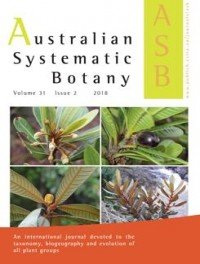Australian Systematic Botany Q2 Unclaimed
Australian Systematic Botany is an international journal devoted to the systematics, taxonomy, and related aspects of biogeography and evolution of all algae, fungi and plants, including fossils. Descriptive taxonomic papers should normally constitute a comprehensive treatment of a group. Short papers on individual species and nomenclatural papers must contain significant new information of broader interest to be considered. The prestigious L.A.S. Johnson Review Series is published. Other review articles will also be considered. All papers are peer reviewed. It has an SJR impact factor of 0,541.
Type: Journal
Type of Copyright:
Languages: English
Open Access Policy: Open Choice
Type of publications:
Publication frecuency: -
2500 €
Inmediate OANPD
Embargoed OA0 €
Non OAMetrics
0,541
SJR Impact factor46
H Index15
Total Docs (Last Year)42
Total Docs (3 years)980
Total Refs72
Total Cites (3 years)42
Citable Docs (3 years)2.23
Cites/Doc (2 years)65.33
Ref/DocOther journals with similar parameters
Journal of Applied Phycology Q2
Journal of Plant Biology Q2
Systematics and Biodiversity Q2
Fungal Ecology Q2
Fermentation Q2
Compare this journals
Aims and Scope
Best articles by citations
The genus Taxithelium (Bryopsida, Sematophyllaceae) in Australia
View moreA revision of Pultenaea (Fabaceae). 1. Species with ovaries glabrous and/or with tufted hairs
View moreMarine and estuarine benthic green algae (Chlorophyta) of Lord Howe Island, south-western Pacific
View moreFrom species to supertrees: Popperian corroboration and some current controversies in systematics
View moreMolecular phylogeny of the tribe Anthospermeae (Rubiaceae): Systematic and biogeographic implications
View moreCatalogue of the marine benthic macroalgae of the Fiji Islands, South Pacific
View moreAustralian boletes: their diversity and possible origins
View moreStudies on Plagiochila subgenus Metaplagiochila (Plagiochilaceae, Hepaticae)
View moreFungi anamorphici in Australasia
View moreA phylogeny inferred from large-subunit (26S) ribosomal DNA sequences suggests that Burmanniales are polyphyletic
View morePetal epidermal micromorphology in holoparasitic Orobanchaceae and its significance for systematics and pollination ecology
View moreIntra- and interspecific allozyme variation in eucalypts from the spotted gum group, Corymbia, section 'Politaria' (Myrtaceae)
View moreCylindrosympodium cryptocaryae sp. nov. (anamorphic fungi), with keys to the described species and to similar genera
View moreSphaerolobium macranthum (Leguminosae: Mirbelieae) complex revised
View moreApplication of RAPD and ISSR markers to analyse molecular relationships in Grevillea (Proteaceae)
View moreFigs, wasps and species concepts: a re-evaluation of the infraspecific taxa of Ficus macrophylla (Moraceae: Urostigma sect. Malvanthera)
View moreSystematic studies in Paniceae (Poaceae): Homopholis and Whalleya gen. et sp. nov.
View morePhylogenetic positions of Actites megalocarpa and Sonchus hydrophilus (Sonchinae: Asteraceae) based on ITS and chloroplast non-coding DNA sequences
View moreSexual reproduction by Phytophthora macrochlamydospora: a group VI species
View moreMonimiaceae sensu lato, an element of Gondwanan polar forests: Evidence from the late Cretaceous-early tertiary wood flora of Antarctica
View moreMorphological and taxonomic studies of selected genera from the tribe Amansieae (Rhodomelaceae, Rhodophyta)
View moreStudies in the genus Galerina (Agaricales) in Australia
View moreShort Note: Ficus rubiginosa f. glabrescens (F.M.Bailey) D.J.Dixon: a new taxonomic status for an old Bailey name
View moreRevison of of some Australasian taxa of Perenniporia (Basidiomycetes, Aphyllophorales)
View more


Comments